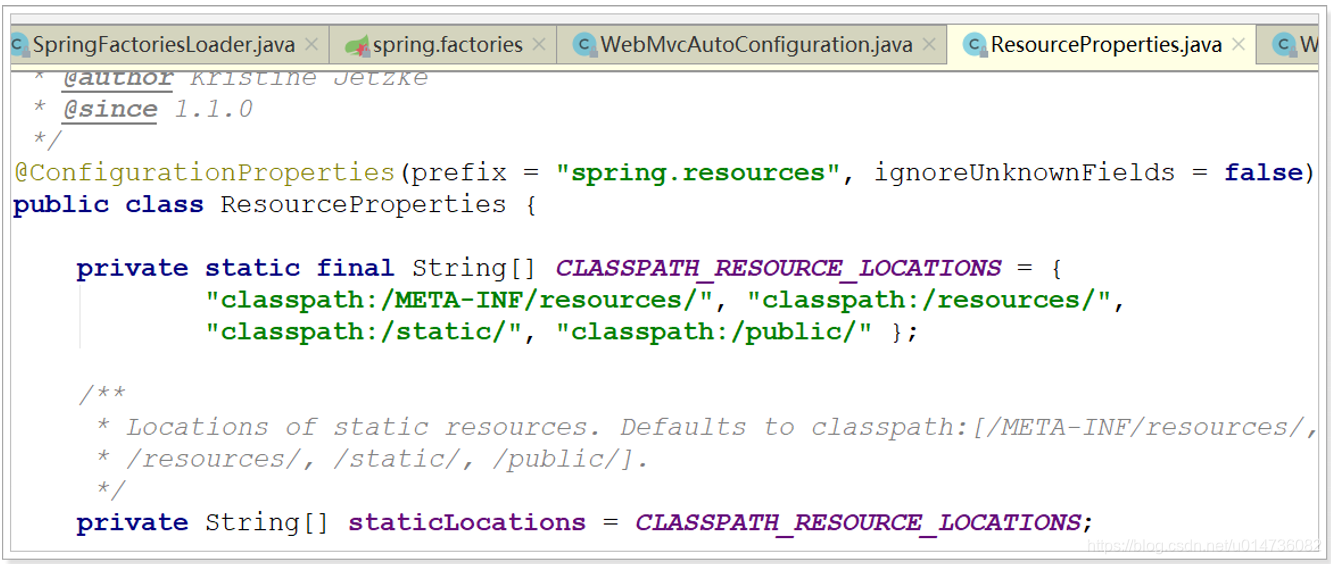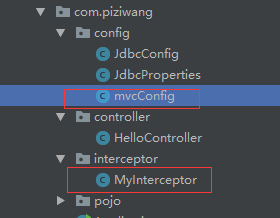07 整合Spring MVC
虽然默认配置已经可以使用SpringMVC了,不过我们有时候需要进行自定义配置。
可以在 application.yml 文件中配置日志级别控制:
logging:
level:
com.piziwang: debug
org.springframework: info
1.修改端口
查看SpringBoot的全局属性可知,端口通过以下方式配置:
修改 application.yml 配置文件,添加如下配置(左侧顶格写):
#tomcat端口
server:
port: 80
#日志记录级别
logging:
level:
com.itheima: debug
org.springframework: info
2.访问静态资源
现在,我们的项目是一个jar工程,那么就没有webapp,我们的静态资源该放哪里呢? 回顾我们在上面看的源码,有一个叫做ResourceProperties的类,里面就定义了静态资源的默认查找路径:

默认的静态资源路径为:
- classpath:/META-INF/resources/
- classpath:/resources/
- classpath:/static/
- classpath:/public
只要静态资源放在这些目录中任何一个,SpringMVC都会帮我们处理。
我们习惯会把静态资源放在 classpath:/static/目录下。我们创建目录 static ,并且从 资料文件夹中复制 piziwang.gif 和 test.js 如下:

3.添加拦截器
拦截器也是我们经常需要使用的,在SpringBoot中该如何配置呢?
拦截器不是一个普通属性,而是一个类,所以就要用到java配置方式了。在SpringBoot官方文档中有这么一段说明:
If you want to keep Spring Boot MVC features and you want to add additional MVC configuration (interceptors, formatters, view controllers, and other features), you can add your own @Configuration class of type WebMvcConfigurer but without @EnableWebMvc . If you wish to provide custom instances of RequestMappingHandlerMapping , RequestMappingHandlerAdapter , or ExceptionHandlerExceptionResolver , you can declare a WebMvcRegistrationsAdapter instance to provide such components.
If you want to take complete control of Spring MVC, you can add your own @Configuration annotated with @EnableWebMvc .
翻译:
如果你想要保持Spring Boot 的一些默认MVC特征,同时又想自定义一些MVC配置(包括:拦截器,格式化器, 视图控制器、消息转换器 等等),你应该让一个类实现 WebMvcConfigurer ,并且添加 @Configuration 注 解,但是千万不要加 @EnableWebMvc 注解。如果你想要自定义 HandlerMapping 、 HandlerAdapter 、 ExceptionResolver 等组件,你可以创建一个 WebMvcRegistrationsAdapter 实例 来提供以上组件。
如果你想要完全自定义SpringMVC,不保留SpringBoot提供的一切特征,你可以自己定义类并且添加 @Configuration 注解和 @EnableWebMvc 注解
总结:通过实现 WebMvcConfigurer 并添加 @Configuration 注解来实现自定义部分SpringMvc配置。
3.1 创建 拦截器,内容 如下:
package com.piziwang.interceptor;
import lombok.extern.slf4j.Slf4j;
import org.springframework.lang.Nullable;
import org.springframework.web.servlet.HandlerInterceptor;
import org.springframework.web.servlet.ModelAndView;
import javax.servlet.http.HttpServletRequest;
import javax.servlet.http.HttpServletResponse;
@Slf4j
public class MyInterceptor implements HandlerInterceptor {
@Override
public boolean preHandle(HttpServletRequest request, HttpServletResponse response, Object handler) throws Exception {
log.debug("这是MyInterceptor拦截器preHandle方法");
return true;
}
@Override
public void postHandle(HttpServletRequest request, HttpServletResponse response, Object handler, @Nullable ModelAndView modelAndView) throws Exception {
log.debug("这是MyInterceptor拦截器postHandle方法");
}
@Override
public void afterCompletion(HttpServletRequest request, HttpServletResponse response, Object handler, @Nullable Exception ex) throws Exception {
log.debug("这是MyInterceptor拦截器afterCompletion方法");
}
}
3.2 定义配置类用于注册拦截 器,内容如下:
package com.piziwang.config;
import com.piziwang.interceptor.MyInterceptor;
import org.springframework.context.annotation.Bean;
import org.springframework.context.annotation.Configuration;
import org.springframework.web.servlet.config.annotation.InterceptorRegistry;
import org.springframework.web.servlet.config.annotation.WebMvcConfigurer;
@Configuration
public class mvcConfig implements WebMvcConfigurer {
@Bean
public MyInterceptor myInterceptor(){
return new MyInterceptor();
}
@Override
public void addInterceptors(InterceptorRegistry registry) {
registry.addInterceptor(myInterceptor()).addPathPatterns("/*");
}
}
结构如下:

3.3运行结果
访问:http://localhost/hello

3.3运行结果
访问:http://localhost/hello





 本文介绍如何在SpringBoot项目中整合SpringMVC,包括配置日志级别、修改服务器端口、处理静态资源及添加自定义拦截器。通过实现WebMvcConfigurer接口并添加@Configuration注解,可以自定义SpringMVC的部分配置。
本文介绍如何在SpringBoot项目中整合SpringMVC,包括配置日志级别、修改服务器端口、处理静态资源及添加自定义拦截器。通过实现WebMvcConfigurer接口并添加@Configuration注解,可以自定义SpringMVC的部分配置。
















 267
267

 被折叠的 条评论
为什么被折叠?
被折叠的 条评论
为什么被折叠?








